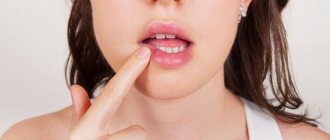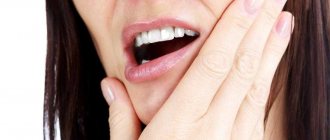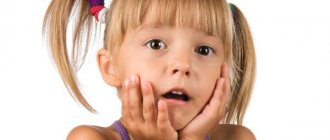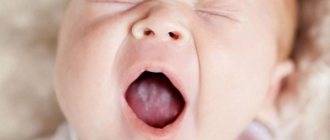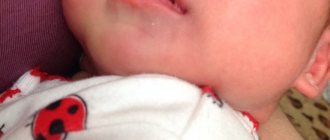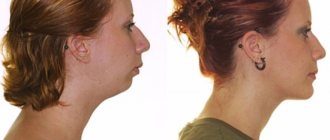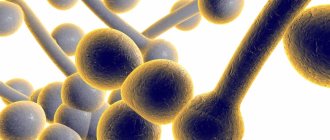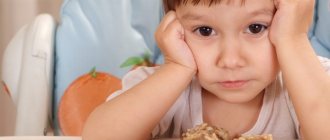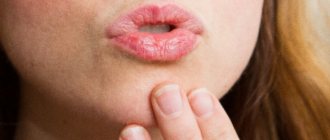The birth of a baby is always a joy for young parents. Naturally, all the attention of the mother and father is focused on the child. They can't get enough of how well he eats, sleeps and smiles back at them.
- Causes of lower lip tremor in babies
- Complications and consequences of tremor
- What measures should be taken if a baby’s lower lip is shaking?
But when the baby starts crying and the parents notice their lips trembling, they become alarmed. Therefore, we will look at why a newborn’s lower lip is shaking.
Causes of lower lip tremor in babies
Often mothers notice that their child’s lower lip shakes when the baby is at rest. And here the parents begin to panic. The thought immediately pops into their head that their little one is seriously ill with something.
Tremor is a shaking associated with involuntary contraction of the mental, triangular and quadratus muscles of the lower lip. Now let's look at the reasons for the formation of tremors from the norm and pathology.
- Response to stimuli (cold, stress, loud sound, sudden influx of bright light).
- When a newborn is stressed, an uncontrolled amount of norepinephrine is released from the adrenal cortex, which enters the bloodstream. NA causes vasospasm and contraction of smooth muscle tissue.
- An underdeveloped central nervous system is unable to regulate the baby's movements.
Among the stressful situations why a newborn's lower lip shakes, one can highlight: bathing, intestinal colic (pain), the moment of changing clothes, a state of hunger, and ordinary fatigue.
- Involuntary muscle contraction at rest.
- Joint trembling of the chin and lower lip, limbs, head.
- Frequently recurring tremors.
- After three months of age, trembling becomes more frequent.
The causes of pathological tremor are:
- prematurity (in premature children, trembling is observed up to 1.5-2 years);
- stress during pregnancy;
- developmental disorder of the peripheral nervous system (PNS);
- increased ICP (intracranial pressure);
- increased blood sugar in a newborn;
- maternal diabetes mellitus or impaired glucose tolerance during pregnancy;
- birth trauma (long, protracted labor; injury received when the head passes through the birth canal);
- Polyhydramnios, infections during pregnancy and a deficiency of essential microelements and vitamins (in particular Mg and B vitamins) can cause disruption in the development of the central nervous system (hereinafter referred to as the CNS) of the fetus.
A child has tremors: when should you see a doctor?
It is necessary to consult a neurologist and conduct a comprehensive examination in the following cases:
- tremor did not go away until 4 months;
- trembling first appeared at the age of 2-4 months and does not disappear;
- the occurrence of tremor is not associated with stress, overexcitation, exposure to water and other factors;
- the child does not gain weight, there is no increase in height, his motor development does not meet age requirements;
- the size of the skull increases or decreases too quickly;
- the child experiences twitching of the head and neck, increased sweating, and bluish skin;
- in addition to tremor, symptoms of intracranial hypertension are observed;
- There is information that the baby was born prematurely and suffered hypoxia during childbirth or in utero.
Complications and consequences of tremor
Physiological tremor does not pose any danger to the health of an infant. After 3-4 months after birth, trembling of the chin and lower lip disappears and no longer bothers either the child or his parents.
As for pathological tremor, here things are much more complicated. Prolonged and frequently recurring tremor is the first alarm bell indicating neuropathy. Involuntary contraction of the muscles of the chin, lips, upper and lower extremities, and head may indicate the presence of perinatal encephalopathy in the baby.
This pathology may include various disorders of the central nervous system that arise as a result of intrauterine development. If you consult a doctor in a timely manner, the disease can still be treated.
If the tremor of the lips and chin is not caused by neurology, then it is necessary to undergo a set of examinations to determine whether there is a deficiency of Ca and Mg in the baby’s body, and diabetes mellitus.
Diagnostics
To make a diagnosis, the pediatrician gets acquainted with information regarding the course of pregnancy and childbirth, evaluates the child’s reflexes, condition and physical development using the Apgar scale. He analyzes the clinical picture, if necessary, prescribes laboratory and instrumental diagnostic methods.
Laboratory techniques for identifying the causes of convulsive muscle contractions include the study of biochemical blood parameters. They make it possible to find out the content of calcium, sugar, magnesium, and organic phosphorus in the blood serum. With their help, hyperglycemia, hypocalcemia, and hypomagnesemia are confirmed or excluded.
You can donate blood for testing free of charge at a public medical institution at your place of residence. In paid clinics and private medical laboratories, the cost of tests varies.
Approximately it consists of:
- sugar 260 rub.;
- calcium 140 rub.;
- magnesium 160 rub.
Upon referral from a neurologist, depending on the condition of the newborn, several types of hardware diagnostic examinations are performed. Due to the policy of the medical center and different characteristics of the installed equipment, prices for the same service may differ up or down:
- Neurosonography. Through incompletely closed sutures of the skull or fontanel, tumors, hemorrhages and other anomalies are detected using ultrasound, and the condition of the brain is assessed. NSG is safe and does not require prior preparation. The procedure takes no more than 10 minutes. The cost of a brain ultrasound will cost 400-900 rubles.
- Electroencephalography . A cap with electrodes that are connected to an electroencephalograph is placed on the child’s head. The method allows you to make a graphical recording of the electrical activity of the brain. EEG makes it possible to give an indirect assessment of the maturity and activity of brain structures. The reception is harmless; it is advisable to carry out the examination while the child is sleeping, since in this case the results are most informative. The price of the service is in the range of 2700-11700 rubles.
- Magnetic resonance and computed tomography . MRI and CT scans create layer-by-layer photographs of all brain structures, spacing several millimeters between images. The relative safety of X-ray doses is compensated by the effectiveness of examinations. A CT scan is performed in a few minutes, an MRI takes 30 minutes, but is more informative. Typically, children under 1 year of age are examined using magnetic resonance imaging while they are asleep. Prices for CT start from 2150 rubles, for MRI from 2000 rubles.
- Electroneuromyography . Electrodes are connected to the child’s hand, muscle contractions are recorded using a myograph, and the speed of electrical impulses passing through the nerve fibers is determined. This method provides accurate information about the causes of increased nervous sensitivity, allows one to identify damage to one nerve or nerve plexuses, and assess the nature and severity of deviations from the norm. The study takes 30-60 minutes and does not require preparation. The cost and duration of the procedure depends on the area of examination. The average price for ENMG is within the range of 1210-6000 rubles.
Modern instrumental methods make it possible to clarify the cause of the pathological condition.
Conclusions upon completion of examinations do not qualify as diagnoses. Only a neurologist can prescribe studies based on strict indications, taking into account contraindications, and interpret their results.
What measures should be taken if a baby’s lower lip is shaking?
Above we discussed why a newborn’s lower lip shakes. Now let’s look at how parents should act in such a situation. When a pathological tremor has been identified in an infant, a neurologist will treat it.
When an infant’s lower lip and chin shake under stress, you need to do the following:
- Do not panic and do not jump near the baby shouting “Oh!” and “Ay!” The baby needs to create a cozy and comfortable environment. Better yet, kiss the little one!
- Get rid of the cause of stress (turn off the music, turn off too bright lights).
- If you have the opportunity to breastfeed your baby, then you need to continue in the same spirit. No mixtures!
- Control your sleep patterns. Feeding, sleeping, and waking the child should take place at the scheduled time.
- Walk with your baby in the fresh air for at least 3 hours.
- Pay attention to the baby's clothing. It should not allow the child to overheat.
- Feel free to harden your baby by wiping him with a towel.
- Massage.
After visiting a neurologist, you may be prescribed a relaxing massage and sea salt baths. The massage procedure can be carried out either in a clinic with a massage therapist or at home.
The massage itself should not last more than 10 minutes.
Knowing all this, you shouldn't panic. If you are concerned about tremor of the baby's lower lip, contact your local pediatrician, who will prescribe an examination if necessary.
www.preobrazhenie.ru - Transfiguration Clinic - anonymous consultations, diagnosis and treatment of diseases of higher nervous activity.
- If you have questions for the consultant, ask him via a personal message or use the “ask a question” form on the pages of our website.
You can also contact us by phone:
- 8 495-632-00-65 Multichannel
- 8 800-200-01-09 Calls within Russia are free
Your question will not remain unanswered!
We were the first and remain the best!
CREATE NEW MESSAGE.
But you are an unauthorized user.
If you have registered previously, then “log in” (login form in the upper right part of the site). If this is your first time here, please register.
If you register, you will be able to further track responses to your messages and continue the dialogue on interesting topics with other users and consultants. In addition, registration will allow you to conduct private correspondence with consultants and other users of the site.
Any unusual behavior of a baby frightens young parents. When a newborn's lower lip trembles, they may panic. After all, he is so small and vulnerable. How to understand what is happening to him? The first thought that appears is that the child is cold. The mother takes the child in her arms and tries to warm him up. In the mother's arms, the baby often calms down, and his lips stop trembling. But there are times when a baby’s chin shakes in a warm room and in the mother’s arms. It is difficult for parents to find an explanation for this. This means that something is wrong with the baby and he is sick. Is this condition a sign of a disease?
Tremor in a baby: is treatment required?
Physiological tremor goes away on its own and does not require specialized medical care. If, as a result of the examination, disorders of the nervous, endocrine systems or other diseases were discovered in the baby, treatment is aimed at eliminating the cause of the pathological trembling.
Drug therapy for neurological disorders includes vitamins, vascular drugs, nootropics, and diuretics. For minor disorders, the neurologist recommends taking a course of therapeutic massage and exercise therapy, and prescribes physiotherapeutic procedures (electrophoresis, magnetic therapy, etc.).
A balanced, nutritious diet, daily routine, and the psychological situation in the family play an important role in the treatment of tremor. Since it often occurs during emotional excitement and stress, a comfortable, calm environment should be created for the child. The baby needs to sleep well and take a walk in the fresh air every day. Foods that stimulate the nervous system (tea, chocolate) are completely excluded from the diet; herbal decoctions with a sedative effect are introduced into the menu.
The prognosis for tremor is most often favorable. In order not to miss serious illnesses that are accompanied by trembling, and to prevent dangerous complications, it is necessary to promptly consult a child with a specialist. A pediatric neurologist at the Edkarik clinic in Kaliningrad will help you find out the cause of the tremor and advise how to cope with it.
Physiological causes of chin tremors in infants
Trembling (tremor) of the chin is often observed in very tiny children. Typically, a newborn's lower lip will quiver when he is excited, cries a lot, is very upset, or is in pain. At this moment, his arms or legs may also tremble.
The cause of this condition is usually the imperfection of the baby’s nervous and endocrine systems. When he is scared or angry, his adrenal glands produce stress hormones - adrenaline and norepinephrine. The baby’s adrenal glands have not yet adjusted their work, so more hormones are produced than necessary. Excess hormones literally burn the baby's muscles, causing them to contract. But this condition passes quickly enough as soon as the baby calms down. Therefore, the tremor often disappears after the mother takes the child in her arms. The baby is calmed by contact with his mother's body.
Most children develop trembling of the chin or lips in the first months of life. It is considered normal for tremors to appear after prolonged crying, physical activity or emotional overexcitation. A baby may become overexcited after playing for a long time or due to a prolonged lack of sleep.
But why does a newborn's lip tremble when he is calm?
Prevention
The main preventive measures come down to pregnancy planning and preliminary treatment of diseases of the expectant mother. Together with giving up bad habits and a calm lifestyle, they help prevent lip shaking.
If a newborn exhibits a symptom, it is necessary to create an environment in which he will be protected from a surge of strong positive or negative emotions.
To do this you need:
- maintain a daily routine and take frequent walks;
- protect the child from bright lights and loud sounds;
- surround it with a cozy and calm atmosphere;
- continue breastfeeding, but do not apply to the breast when the mother is in an excited state;
- carry out preparations for walks and hygiene procedures calmly;
- Give your child a massage to relieve muscle hypertonicity.
If a newborn's lower lip or chin often shakes, massage will help calm him down and relieve tension. Contact of
the newborn's skin with the mother's skin, gentle stroking, carrying the baby in a kangaroo, soothing warm baths help reduce the severity of the symptom and reduce the newborn's reaction to irritants.
Muscle hypertonicity
Sometimes a baby's shaky chin appears even when he is calm. The cause of this phenomenon may be muscle hypertonicity. This is a limitation of the voluntary motor function of the infant, caused by certain disorders in the development of the brain and peripheral nerve. With hypertonicity, the baby's muscles are overstrained. They remain tense even when the baby is in a relaxed state.
Other signs of hypertonicity are poor quality sleep (the baby sleeps little and poorly), increased irritability, frequent regurgitation after feeding, throwing back the head and unnatural arching of the body.
If you suspect hypertonicity, you can conduct an experiment. You need to take the baby under the armpits and place him on a hard surface, slightly tilting him forward. In this position, babies begin to instinctively move their legs, as when walking. A baby with hypertonicity will stand on his toes, while a healthy baby will stand on his entire foot. This is a classic diagnostic sign of hypertension and dysfunction of the nervous system.
Possible complications
The diagnosis of prenatal damage to the central nervous system is made on average by 6% of full-term and 65% of premature children. In early childhood, they account for over 60% of other CNS pathologies. Their danger lies in the fact that such damage is involved in the development of epilepsy, minimal brain dysfunction, and cerebral palsy.
The child’s recovery depends on the timeliness and correctness of therapy and the degree of damage to brain tissue. 35% of newborns require minor rehabilitation support, 30% require serious drug therapy.
It is important to carefully monitor the child after birth, to note the characteristics of his reactions and conditions. This will help to catch the difference between a physiological reaction and a symptom of the disease, to carry out examination and treatment in a timely manner.
If the manifestation of a quivering lower lip cannot be attributed to natural causes, and any deviation from the norm is detected in the newborn, in most cases it can be successfully treated and does not complicate the further development of the child.
Other reasons
Muscle tremors often accompany in the first months of life those babies who suffered from oxygen starvation in the womb.
Oxygen starvation of the fetus is called hypoxia. It occurs when placental abruption, entanglement with the umbilical cord, in the event of a threat of miscarriage, or due to other disorders of placental blood flow. Fetal hypoxia can be caused by infectious diseases, polyhydramnios, or bleeding. Lack of oxygen affects brain development and causes tremors in children.
Chin trembling often affects children whose mothers were in a state of nervous tension during pregnancy. During pregnancy, a woman's body produces a lot of stress hormones. They penetrated the placenta and entered the baby’s blood. Maternal stress hormones could cause disturbances in the functioning of the child’s nervous and endocrine systems.
How to determine the cause of tremor?
Further treatment tactics depend on the cause of pathological tremors. Comprehensive diagnostics includes a neurological examination, laboratory and hardware tests.
When collecting anamnesis, the pediatric neurologist clarifies the following information from the mother:
- did she have any complications during pregnancy, did she have any infectious diseases, did she take any medications;
- how the birth proceeded;
- whether the child had asphyxia during childbirth, whether resuscitation measures were carried out;
- at what stage the baby was born, his height and weight at birth;
- whether the child was separated from the mother in the maternity hospital;
- results of examination of the baby in the maternity hospital;
- features of feeding a child;
- what manifestations of the baby, besides tremor, are currently worrying the parents, etc.
At home, parents can conduct rapid video recording of the child, which will later allow the doctor to assess the amplitude of the tremor, its frequency, and the symmetry of the manifestation of the tremor.
To identify the pathology that led to the appearance of tremor, the following diagnostic methods are prescribed:
- CT or MRI of the brain;
- angiography of cerebral vessels;
- radiography of the skull bones;
- electroencephalography;
- blood tests for calcium, magnesium, glucose, bilirubin;
- hormonal panel (adrenal, thyroid, pituitary hormones).
In order to carry out differential diagnosis of tremor with hyperkinesis, electromyography is used, which makes it possible to record involuntary muscle contractions.
When should tremors be treated?
As a rule, lip trembling in most children goes away on its own by the age of three months. If at 3 months the baby continues to suffer from tremors, he may have developmental pathologies. A particularly alarming sign is tremor of the limbs and head, which does not weaken over time, but even intensifies. This indicates a clear neurological disorder.
This condition may indicate that the child has hypocalcemia, hyperglycemia, hypomagnesemia, sepsis, intracranial hemorrhage, or increased intracranial pressure. Therefore, the baby urgently needs to be shown to a neurologist.
It is also recommended to consult a neurologist if there is a suspicion of hypertension in the baby.
In addition to drug treatment, the doctor will prescribe therapeutic exercises and massage. Swimming is very beneficial for all children with tremors and other manifestations of nervous disorders. You can visit the baby pool or organize swims at home in the bathroom. Such procedures have an excellent effect on the baby’s nervous system and muscle tone. At home, you need to create a comfortable, calm and peaceful environment for your child.
Treatment methods
The choice of treatment method is influenced by the reason that gave rise to the symptom. When it is a direct consequence of pathology, the pediatrician and neurologist establish the disease.
Doctors, taking into account the child’s condition and the severity of the process, select a drug, prescribe a course of therapy and, if necessary, make adjustments to the treatment. They supplement the medicinal effect with therapeutic massage and gymnastics.
When involuntary muscle contractions occur due to physiological reasons, neurologists do not prescribe medications. Parents are advised to take time to observe the child and monitor the dynamics of his development.
In the second case, the lower lip of a newborn shakes due to muscle hypertonicity; to reduce it, neurologists recommend:
- Once a week, take a bath in water with the addition of a decoction of lemon balm, mint, chamomile, and string;
- Organize water treatments daily to calm the nervous system and relax muscles with warm baths;
- conduct massage sessions and gymnastics.
Gymnastics for newborns in water
Gymnastic exercises consist of smoothly crossing and spreading the arms, “bicycle”, bending the legs towards the stomach, raising and lowering the arms, bending the child’s arms towards the shoulder joints.
Pediatricians advise starting massage when the newborn reaches 6 weeks of age. The effectiveness of the procedure increases when it is performed before swimming. Stroking, rubbing, kneading, vibration are the main massage techniques that need to be performed from the periphery to the center.
Basic movements include:
- stroking the face, starting with the eyebrows and cheeks;
- gentle stroking of arms and legs;
- gently kneading your fingers;
- smooth stroking of the chest and back in a herringbone pattern;
- massaging the legs in the direction from the feet to the thigh;
- stroking the abdomen in a circular motion with the entire palm in a clockwise direction.
Massage sessions should be carried out while the child is awake, carefully monitoring his mood. If he begins to show dissatisfaction, you should stop the session and return to the lesson later.
Tics in children
Tics, or hyperkinesis, are repeated, unexpected short stereotypical movements or statements that are superficially similar to voluntary actions. A characteristic feature of tics is their involuntary nature, but in most cases the patient can reproduce or partially control his own hyperkinesis. With a normal level of intellectual development in children, the disease is often accompanied by cognitive impairment, motor stereotypies and anxiety disorders.
The prevalence of tics reaches approximately 20% in the population.
There is still no consensus on the occurrence of tics. The decisive role in the etiology of the disease is given to the subcortical nuclei - the caudate nucleus, globus pallidus, subthalamic nucleus, and substantia nigra. Subcortical structures interact closely with the reticular formation, thalamus, limbic system, cerebellar hemispheres and the frontal cortex of the dominant hemisphere. The activity of subcortical structures and frontal lobes is regulated by the neurotransmitter dopamine. Insufficiency of the dopaminergic system leads to disturbances of attention, lack of self-regulation and behavioral inhibition, decreased control of motor activity and the appearance of excessive, uncontrolled movements.
The effectiveness of the dopaminergic system can be affected by intrauterine developmental disorders due to hypoxia, infection, birth trauma, or hereditary deficiency of dopamine metabolism. There are indications of an autosomal dominant type of inheritance; However, it is known that boys suffer from tics approximately 3 times more often than girls. Perhaps we are talking about cases of incomplete and sex-dependent penetration of the gene.
In most cases, the first appearance of tics in children is preceded by external unfavorable factors. Up to 64% of tics in children are provoked by stressful situations - school maladjustment, extracurricular activities, uncontrolled watching of TV shows or prolonged work on the computer, conflicts in the family and separation from one of the parents, hospitalization.
Simple motor tics can be observed in the long-term period of a traumatic brain injury. Vocal tics - coughing, sniffing, expectorating throat sounds - are often found in children who often suffer from respiratory infections (bronchitis, tonsillitis, rhinitis).
In most patients, there is a diurnal and seasonal dependence of tics - they intensify in the evening and become aggravated in the autumn-winter period.
A separate type of hyperkinesis includes tics that arise as a result of involuntary imitation in some highly suggestible and impressionable children. This happens in the process of direct communication and under the condition of a certain authority of the child with tics among his peers. Such tics go away on their own some time after the cessation of communication, but in some cases such imitation is the debut of the disease.
Clinical classification of tics in children
By etiology
Primary, or hereditary, including Tourette's syndrome. The main type of inheritance is autosomal dominant with varying degrees of penetration; sporadic cases of the disease are possible.
Secondary or organic. Risk factors: anemia in pregnant women, maternal age over 30 years, fetal malnutrition, prematurity, birth trauma, previous brain injuries.
Cryptogenic. They occur against the background of complete health in a third of patients with tics.
According to clinical manifestations
Local (facial) tic. Hyperkinesis affects one muscle group, mainly facial muscles; frequent blinking, squinting, twitching of the corners of the mouth and wings of the nose predominate (Table 1). Blinking is the most persistent of all local tic disorders. Closed eyes are characterized by a more pronounced disturbance of tone (dystonic component). Movements of the wings of the nose, as a rule, are associated with rapid blinking and are among the unstable symptoms of facial tics. Single facial tics practically do not interfere with patients and in most cases are not noticed by the patients themselves.
| Table 1 Types of motor tics (V.V. Zykov) |
Common tic. Several muscle groups are involved in hyperkinesis: facial muscles, muscles of the head and neck, shoulder girdle, upper limbs, abdominal and back muscles. In most patients, a common tic begins with blinking, which is accompanied by opening the gaze, turning and tilting the head, and lifting the shoulders. During periods of exacerbation of tics, schoolchildren may have problems completing written assignments.
Vocal tics. There are simple and complex vocal tics.
The clinical picture of simple vocal tics is represented mainly by low sounds: coughing, “clearing the throat,” grunting, noisy breathing, sniffing. Less common are high-pitched sounds such as “i”, “a”, “oo-u”, “uf”, “af”, “ay”, squealing and whistling. With an exacerbation of tic hyperkinesis, vocal phenomena may change, for example, coughing turns into grunting or noisy breathing.
Complex vocal tics are observed in 6% of patients with Tourette syndrome and are characterized by the pronunciation of individual words, swearing (coprolalia), repetition of words (echolalia), and rapid, uneven, unintelligible speech (palilalia). Echolalia is an intermittent symptom and may occur over several weeks or months. Coprolalia usually represents a status condition in the form of serial utterance of swear words. Often, coprolalia significantly limits the child’s social activity, depriving him of the opportunity to attend school or public places. Palilalia is manifested by obsessive repetition of the last word in a sentence.
Generalized tic (Tourette's syndrome). Manifests itself as a combination of common motor and vocal simple and complex tics.
Table 1 presents the main types of motor tics depending on their prevalence and clinical manifestations.
As can be seen from the table presented, as the clinical picture of hyperkinesis becomes more complex, from local to generalized, tics spread from top to bottom. Thus, with a local tic, violent movements are noted in the facial muscles; with a widespread tic, they move to the neck and arms; with a generalized tic, the torso and legs are involved in the process. Blinking occurs with equal frequency in all types of tics.
According to the severity of the clinical picture
The severity of the clinical picture is assessed by the number of hyperkinesis in the child during 20 minutes of observation. In this case, tics can be absent, single, serial or status. Severity assessment is used to standardize the clinical picture and determine the effectiveness of treatment.
With single tics, their number during 20 minutes of examination ranges from 2 to 9; they are more common in patients with local forms and in remission in patients with widespread tics and Tourette's syndrome.
With serial tics, during a 20-minute examination, from 10 to 29 hyperkinesis are observed, after which many hours of breaks occur. A similar picture is typical during exacerbation of the disease and occurs in any localization of hyperkinesis.
With tic status, serial tics follow with a frequency of 30 to 120 or more per 20 minutes of examination without a break during the day.
Similar to motor tics, vocal tics can also be single, serial and status, intensifying in the evening, after emotional stress and overwork.
According to the course of the disease
According to the Diagnostic and Statistical Manual of Mental Disorders (DSM-IV), there are transient tics, chronic tics and Tourette's syndrome.
A transient , or transient , course of tics implies the presence of motor or vocal tics in a child with complete disappearance of symptoms of the disease within 1 year. Characteristic of local and widespread tics.
Chronic tic disorder is characterized by motor tics lasting more than 1 year without a vocal component. Chronic vocal tics in isolated form are rare. There are remitting, stationary and progressive subtypes of the course of chronic tics.
In a remitting course, periods of exacerbation are replaced by complete regression of symptoms or the presence of local single tics that occur against the background of intense emotional or intellectual stress. The relapsing-remitting subtype is the main variant of the course of tics. With local and widespread tics, exacerbation lasts from several weeks to 3 months, remissions last from 2–6 months to a year, in rare cases up to 5–6 years. With drug treatment, complete or incomplete remission of hyperkinesis is possible.
The stationary type of the disease is determined by the presence of persistent hyperkinesis in various muscle groups, which persist for 2–3 years.
The progressive course is characterized by the absence of remissions, the transition of local tics to widespread or generalized ones, the complication of stereotypes and rituals, the development of tic status, and resistance to therapy. A progressive course predominates in boys with hereditary tics. Unfavorable signs are the presence of aggressiveness, coprolalia, and obsessions in the child.
There is a relationship between the localization of tics and the course of the disease. Thus, a local tic is characterized by a transient-remitting type of course, a widespread tic is characterized by a remitting-stationary type, and Tourette's syndrome is characterized by a remitting-progressive type.
Age dynamics of tics
Most often, tics appear in children aged 2 to 17 years, the average age is 6–7 years, the frequency of occurrence in the pediatric population is 6–10%. Most children (96%) develop tics before age 11. The most common manifestation of a tic is blinking the eyes. At the age of 8–10 years, vocal tics appear, which account for approximately a third of the cases of all tics in children and occur both independently and against the background of motor ones. Most often, the initial manifestations of vocal tics are sniffing and coughing. The disease is characterized by an increasing course with a peak of manifestations at 10–12 years, then a decrease in symptoms is noted. By age 18, approximately 50% of patients become free of tics spontaneously. At the same time, there is no relationship between the severity of the manifestation of tics in childhood and in adulthood, but in most cases in adults the manifestations of hyperkinesis are less pronounced. Sometimes tics first appear in adults, but they are characterized by a milder course and usually last no more than 1 year.
The prognosis for local tics is favorable in 90% of cases. In the case of common tics, 50% of children experience complete regression of symptoms.
Tourette's syndrome
The most severe form of hyperkinesis in children is, without a doubt, Tourette's syndrome. Its frequency is 1 case per 1,000 children in boys and 1 in 10,000 in girls. The syndrome was first described by Gilles de la Tourette in 1882 as a “disease of multiple tics.” The clinical picture includes motor and vocal tics, attention deficit disorder, and obsessive-compulsive disorder. The syndrome is inherited with high penetrability in an autosomal dominant manner, and in boys, tics are more often combined with attention deficit hyperactivity disorder, and in girls - with obsessive-compulsive disorder.
The currently generally accepted criteria for Tourette's syndrome are those given in the DSM III revision classification. Let's list them.
- A combination of motor and vocal tics that occur simultaneously or at different intervals.
- Repeated tics throughout the day (usually in series).
- The location, number, frequency, complexity and severity of tics changes over time.
- The onset of the disease is before 18 years of age, duration is more than 1 year.
- Symptoms of the disease are not associated with the use of psychotropic drugs or central nervous system disease (Huntington's chorea, viral encephalitis, systemic diseases).
The clinical picture of Tourette's syndrome depends on the age of the patient. Knowledge of the basic patterns of disease development helps to choose the right treatment tactics.
The onset of the disease develops at 3–7 years. The first symptoms are local facial tics and shoulder twitching. Then hyperkinesis spreads to the upper and lower extremities, shuddering and turning of the head, flexion and extension of the hand and fingers, throwing the head back, contraction of the abdominal muscles, jumping and squats appear, one type of tics is replaced by another. Vocal tics often join motor symptoms for several years after the onset of the disease and intensify during the acute stage. In a number of patients, vocalisms are the first manifestations of Tourette's syndrome, which are subsequently joined by motor hyperkinesis.
Generalization of tic hyperkinesis occurs over a period lasting from several months to 4 years. At the age of 8–11 years, children experience a peak in clinical manifestations of symptoms in the form of a series of hyperkinesis or repeated hyperkinetic states in combination with ritual actions and auto-aggression. The tic status in Tourette's syndrome characterizes a severe hyperkinetic state. A series of hyperkinesis is characterized by the replacement of motor tics with vocal ones, followed by the appearance of ritual movements. Patients note discomfort from excessive movements, for example, pain in the cervical spine that occurs when turning the head. The most severe hyperkinesis is a throwing back of the head - in this case, the patient can repeatedly hit the back of the head against the wall, often in combination with simultaneous clonic twitching of the arms and legs and the appearance of muscle pain in the extremities. The duration of status tics ranges from several days to several weeks. In some cases, exclusively motor or predominantly vocal tics are noted (coprolalia). During status tics, consciousness in children is completely preserved, but hyperkinesis is not controlled by patients. During exacerbations of the disease, children cannot attend school and self-care becomes difficult for them. It is characterized by a remitting course with exacerbations lasting from 2 to 12–14 months and incomplete remissions from several weeks to 2–3 months. The duration of exacerbations and remissions is directly dependent on the severity of tics.
In most patients, at the age of 12–15 years, generalized hyperkinesis goes into a residual phase , manifested by local or widespread tics. In a third of patients with Tourette's syndrome without obsessive-compulsive disorders in the residual stage, a complete cessation of tics is observed, which can be considered as an age-dependent infantile form of the disease.
Comorbidity of tics in children
Tics often occur in children with pre-existing central nervous system (CNS) conditions, such as attention deficit hyperactivity disorder (ADHD), cerebrasthenic syndrome, and anxiety disorders including generalized anxiety disorder, specific phobias, and obsessive-compulsive disorder.
About 11% of children with ADHD have tics. Mostly these are simple motor and vocal tics with a chronic recurrent course and a favorable prognosis. In some cases, the differential diagnosis between ADHD and Tourette's syndrome is difficult when hyperactivity and impulsivity appear in a child before the development of hyperkinesis.
In children suffering from generalized anxiety disorder or specific phobias, tics can be provoked or intensified by worries and worries, unusual surroundings, prolonged anticipation of an event and a concomitant increase in psycho-emotional stress.
In children with obsessive-compulsive disorder, vocal and motor tics are combined with compulsive repetition of a movement or activity. Apparently, in children with anxiety disorders, tics are an additional, albeit pathological, form of psychomotor discharge, a way of calming and “processing” accumulated internal discomfort.
Cerebrasthenic syndrome in childhood is a consequence of traumatic brain injuries or neuroinfections. The appearance or intensification of tics in children with cerebrasthenic syndrome is often provoked by external factors: heat, stuffiness, changes in barometric pressure. Typically, tics increase with fatigue, after long-term or repeated somatic and infectious diseases, and increased educational loads.
Let us present our own data. Of the 52 children who complained of tics, there were 44 boys and 7 girls; the ratio “boys: girls” was “6:1” (Table 2).
| Table 2 Distribution of children with tics by age and gender |
So, the largest number of calls for tics was observed in boys aged 5–10 years, with a peak at 7–8 years. The clinical picture of tics is presented in Table. 3.
| Table 3 Types of tics in group patients |
Thus, simple motor tics with localization mainly in the muscles of the face and neck and simple vocal tics imitating physiological actions (coughing, expectoration) were most often observed. Jumping and complex vocal expressions were much less common - only in children with Tourette syndrome.
Temporary (transient) tics lasting less than 1 year were observed more often than chronic (remitting or stationary) tics. Tourette's syndrome (chronic stationary generalized tic) was observed in 7 children (5 boys and 2 girls) (Table 4).
| Table 4 Distribution of patients by type of treatment for tics |
Treatment
The main principle of treatment for tics in children is an integrated and differentiated approach to treatment. Before prescribing medication or other therapy, it is necessary to find out the possible causes of the disease and discuss methods of pedagogical correction with parents. It is necessary to explain the involuntary nature of hyperkinesis, the impossibility of controlling them by willpower and, as a consequence of this, the inadmissibility of comments to a child about tics. Often the severity of tics decreases when the demands on the child from the parents are reduced, attention is not focused on his shortcomings, and his personality is perceived as a whole, without isolating “good” and “bad” qualities. Streamlining the regimen and playing sports, especially in the fresh air, have a therapeutic effect. If induced tics are suspected, the help of a psychotherapist is necessary, since such hyperkinesis can be relieved by suggestion.
When deciding whether to prescribe drug treatment, it is necessary to take into account factors such as etiology, age of the patient, severity and severity of tics, their nature, and concomitant diseases. Drug treatment must be carried out for severe, pronounced, persistent tics, combined with behavioral disorders, poor performance at school, affecting the child’s well-being, complicating his adaptation in the team, limiting his opportunities for self-realization. Drug therapy should not be prescribed if the tics only bother the parents but do not interfere with the child's normal activities.
The main group of drugs prescribed for tics are antipsychotics: haloperidol, pimozide, fluphenazine, tiapride, risperidone. Their effectiveness in the treatment of hyperkinesis reaches 80%. The drugs have analgesic, anticonvulsant, antihistamine, antiemetic, neuroleptic, antipsychotic, and sedative effects. The mechanisms of their action include blockade of postsynaptic dopaminergic receptors of the limbic system, hypothalamus, trigger zone of the gag reflex, extrapyramidal system, inhibition of the reuptake of dopamine by the presynaptic membrane and subsequent deposition, as well as blockade of adrenergic receptors of the reticular formation of the brain. Side effects: headache, drowsiness, difficulty concentrating, dry mouth, increased appetite, agitation, restlessness, anxiety, fear. With prolonged use, extrapyramidal disorders may develop, including increased muscle tone, tremor, and akinesia.
Haloperidol: the initial dose is 0.5 mg at night, then it is increased by 0.5 mg per week until a therapeutic effect is achieved (1-3 mg/day in 2 divided doses).
Pimozide (Orap) is comparable in effectiveness to haloperidol, but has fewer side effects. The initial dose is 2 mg/day in 2 divided doses; if necessary, the dose is increased by 2 mg per week, but not higher than 10 mg/day.
Fluphenazine is prescribed at a dose of 1 mg/day, then the dose is increased by 1 mg per week to 2–6 mg/day.
Risperidone belongs to the group of atypical antipsychotics. Risperidone is known to be effective for tics and related behavioral disorders, especially those of an oppositional defiant nature. The initial dose is 0.5–1 mg/day with a gradual increase until positive dynamics are achieved.
Tiaprid (Tiapridal): children 7–12 years old are recommended 50 mg (1/2 tablet) 1–2 times a day.
When choosing a drug to treat a child with tics, you should consider the dosage form that is most convenient for dosing. Optimal for titration and subsequent treatment in childhood are drop forms (haloperidol, risperidone), which allow you to most accurately select a maintenance dose and avoid an unjustified overdose of the drug, which is especially important when carrying out long courses of treatment. Preference is also given to drugs with a relatively low risk of side effects (risperidone, tiapride).
Metoclopramide (Reglan, Cerucal) is a specific blocker of dopamine and serotonin receptors in the trigger zone of the brain stem. For Tourette's syndrome in children, it is used in a dose of 5–10 mg per day (1/2–1 tablet), in 2–3 doses. Side effects include extrapyramidal disorders that occur when the dose exceeds 0.5 mg/kg/day.
In recent years, valproic acid preparations have been used to treat hyperkinesis. The main mechanism of action of valproate is to enhance the synthesis and release of γ-aminobutyric acid, which is an inhibitory neurotransmitter of the central nervous system. Valproates are the first choice drugs in the treatment of epilepsy, but their thymoleptic effect, manifested in a decrease in hyperactivity, aggressiveness, irritability, as well as a positive effect on the severity of hyperkinesis, is of interest. The therapeutic dose recommended for the treatment of hyperkinesis is significantly lower than for the treatment of epilepsy and is 20 mg/kg/day. Side effects include drowsiness, weight gain, and hair loss.
When hyperkinesis is combined with obsessive-compulsive disorder, antidepressants - clomipramine, fluoxetine - have a positive effect.
Clomipramine (Anafranil, Clominal, Clofranil) is a tricyclic antidepressant whose mechanism of action is inhibition of the reuptake of norepinephrine and serotonin. The recommended dose for children with tics is 3 mg/kg/day. Side effects include transient visual disturbances, dry mouth, nausea, urinary retention, headache, dizziness, insomnia, excitability, extrapyramidal disorders.
Fluoxetine (Prozac) is an antidepressant, a selective serotonin reuptake inhibitor with low activity in relation to the norepinephrine and dopaminergic systems of the brain. In children with Tourette's syndrome, it effectively eliminates restlessness, anxiety, and fear. The initial dose in childhood is 5 mg/day once a day, the effective dose is 10–20 mg/day once in the morning. The drug is generally well tolerated, side effects are relatively rare. Among them, the most significant are anxiety, sleep disturbances, asthenic syndrome, sweating, and weight loss. The drug is also effective in combination with pimozide.
Literature
- Zavadenko N. N. Hyperactivity and attention deficit in childhood. M.: ACADEMA, 2005.
- Mash E., Wolf D. Child mental disorders. SPb.: Prime EUROZNAK; M.: OLMA PRESS, 2003.
- Omelyanenko A., Evtushenko O. S., Kutyakova et al. // International Neurological Journal. Donetsk. 2006. No. 3(7). pp. 81-82.
- Petrukhin A. S. Neurology of childhood. M.: Medicine, 2004.
- Fenichel J.M. Pediatric neurology. Fundamentals of clinical diagnosis. M.: Medicine, 2004.
- L. Bradley, Schlaggar, Jonathan W. Mink. Movement // Disorders in Children Pediatrics in Review. 2003; 24(2).
N. Yu. Suvorinova , Candidate of Medical Sciences, Russian State Medical University, Moscow
How to prevent lip tremors in a baby
Tremor prevention measures are aimed at maintaining a stress-free pregnancy and caring for the unborn baby.
- During pregnancy, a woman must understand that she is responsible not only for her own life, but also for the life of her baby. Planning a pregnancy also means giving up bad habits in advance. Be calm, live in harmony with the world around you, find the strength to avoid stress, and periodically listen to calm music.
- If you are sick with chronic or infectious diseases, then they should be cured, because everything is transmitted to the fetus at birth through the placenta.
- Visit your doctor regularly and follow all his instructions.
Fortunately, tremor in an infant is rarely a symptom of severe neurological diseases. And it occurs only in 50% of babies. If you follow your doctor's recommendations during pregnancy, you can avoid the appearance of tremors.
The article has been verified by the editors
